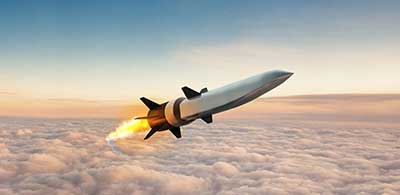Relevance: GS-3: Science and Technology - developments and their applications and effects in everyday life.
Key Phrases: Aeroballistic missiles, Mach speed, Hypersonic Weapons, Congressional Research Service, Hypersonic Technology Demonstrator Vehicle, DRDO.
Why in News?
- The Russian Ministry of Defence announced recently that it had used a hypersonic missile for the first time in the ongoing conflict with Ukraine.
- The Kinzhal aviation missile system with hypersonic aeroballistic missiles destroyed a large underground warehouse containing missiles and aviation ammunition in the village of Deliatyn in the Ivano-Frankivsk region.
What are hypersonic weapons?
- They are manoeuvrable weapons that can fly at speeds of at least Mach 5, five times the speed of sound.
- They are different from Ballistic missiles which even though can travel much faster, follow a fixed trajectory and travel outside the atmosphere to re-enter only near impact.
- On the other hand, hypersonic weapons travel within the atmosphere and can manoeuvre midway which combined with their high speeds make their detection and interception extremely difficult. This means that radars and air defences cannot detect them till they are very close and have only little time to react.
- Hypersonic missiles are a new class of threat because they are capable both of manoeuvring and of flying faster than 5,000 kilometres per hour, which would enable such missiles to penetrate most missile defences and to further compress the timelines for response by a nation under attack, says a 2017 book Hypersonic Missile Nonproliferation published by RAND Corporation.
Note:
- According to the October 2021 memo of the Congressional Research
Service (CRS), ‘Hypersonic Weapons: Background and Issues for
Congress’, there are two classes of hypersonic weapons, Hypersonic
glide vehicles (HGV) and Hypersonic Cruise Missiles (HCM).
- HGVs are launched from a rocket before gliding to a target.
- HCM are powered by high-speed, air-breathing engines, or scramjets, after acquiring their target.
- Scramjet: A scramjet (supersonic combustion ramjet) is an engine designed for speeds beyond Mach 6, which mixes fuel into air flowing through it at supersonic speeds; it is intended for hypersonic aircraft.
What is the status of Russian, Chinese and U.S. programmes?
Russia
- According to Russian news agency TASS, the Kinzhal air-launched hypersonic missile system was unveiled by Russian President on March 1 and has an operating range of over 2,000 km.
- The basic carrier of the missile is the MiG-31K fighter jet as well as the Tu-22M3 bomber.
- Russia recently announced that it had successfully test launched a Tsirkon hypersonic cruise missile from a Severodvinsk submarine deployed in the Barents Sea which hit a target 350 kms away.
- Talking of the test in November, Russian President declared that tests were almost complete and the Russian Navy would start receiving them very soon.
China
- Recently The Financial Times had reported that China tested a nuclear-capable hypersonic missile in August 2021 that circled the globe before speeding towards its target, demonstrating an advanced space capability that caught U.S. intelligence by surprise. However, China has denied that it was nuclear capable.
United States
- The U.S. has tested hypersonic weapons for decades. The first vehicle to exceed Mach 5 was a two-stage rocket launched in 1949 which reached a speed of Mach 6.7, under Project Bumper.
- While the U.S. has active hypersonic development programmes. the CRS memo said it was lagging behind China and Russia because “most U.S. hypersonic weapons, in contrast to those in Russia and China, are not being designed for use with a nuclear warhead.”
- As a result, U.S. hypersonic weapons will likely require greater accuracy and will be more technically challenging to develop than nuclear-armed Chinese and Russian systems.
- It stated the U.S. is now looking to accelerate its own programmes, though it is unlikely to field an operational system before 2023.
- The U.S. has six known hypersonic programmes, divided among the Air Force, Army and Navy, according to them.
What is the status in other countries?
- The CRS Memo noted that although the United States, Russia, and China possess the most advanced hypersonic weapons programmes, a number of other countries — including Australia, India, France, Germany, and Japan — are also developing hypersonic weapons technology.
Position of India
- India operates approximately 12 hypersonic wind tunnels and is capable of testing speeds of up to Mach 13, according to CRS.
- Reportedly, India is also developing an indigenous, dual-capable hypersonic cruise missile as part of its Hypersonic Technology Demonstrator Vehicle (HSTDV) programme and successfully tested a Mach 6 scramjet in June 2019 and September 2020.
- This test was carried out by the Defence Research and Development Organisation (DRDO) and demonstrated the scramjet engine technology, a major breakthrough.
- In a scramjet engine, air goes inside the engine at supersonic speed and comes out at hypersonic speeds.
- After the test in 2020, DRDO had said that with this demonstration many critical technologies such as aerodynamic configuration for hypersonic manoeuvers, use of scramjet propulsion for ignition and sustained combustion at hypersonic flow, thermo-structural characterisation of high temperature materials, separation mechanism at hypersonic velocities have been validated.
- A hypersonic version of the BrahMos supersonic cruise missile, a joint development of India and Russia, is also under development.
Conclusion
- Now, it is especially important to develop and implement the technologies necessary to create new hypersonic weapons systems, high-powered lasers and robotic systems that will be able to effectively counter potential military threats, which means they will further strengthen the security of our country,”
- However the widespread perception that hypersonic weapons are a game-changer has increased tensions among the U.S., Russia and China, driving a new arms race and escalating the chances of conflict.
Sources: The Hindu
Mains Question:
Q. Widespread perception that hypersonic weapons are a game-changer has increased tensions among the U.S., Russia and China, driving a new arms race. Critically analyse the statement. (Words 250).



















